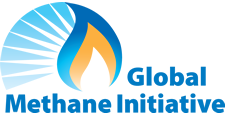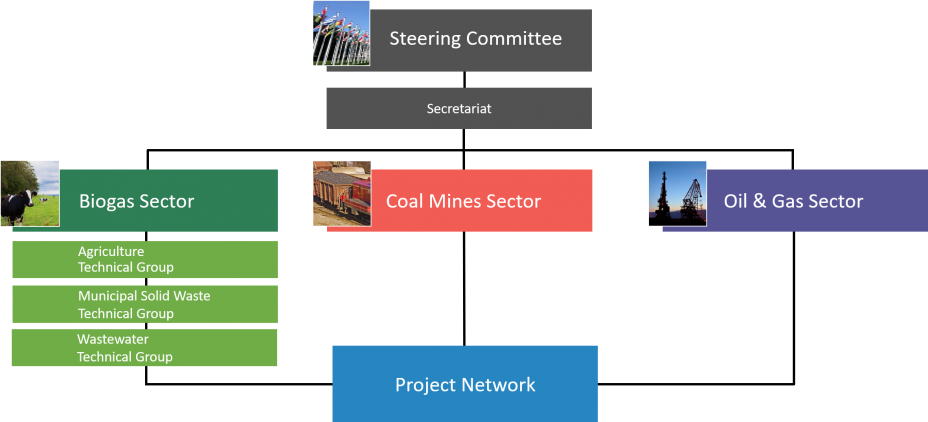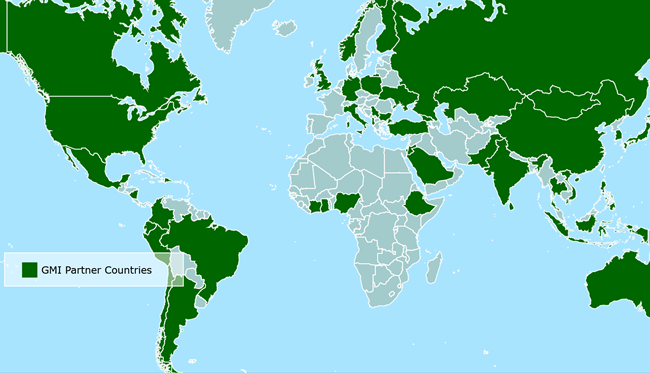Learn About the Global Methane Initiative
 Since 2004
Since 2004
- Supported the identification and implementation of more than 1,100 methane mitigation projects
- Trained more than 15,000 people in methane mitigation techniques
- Grown from 14 to 45 Partner Countries (including the European Commission), and from 100 to more than 700 Project Network Members
- Developed more than 50 tools and publications
- Leveraged nearly $590 million for project development and training
On this page:
About GMI
Launched in 2004, the Global Methane Initiative (GMI) is an international public-private initiative that advances cost effective, near-term methane abatement and recovery and use of methane as a clean energy source in three sectors: biogas (including agriculture, municipal solid waste, and wastewater), coal mines, and oil and gas systems. The Initiative aims to reduce informational, institutional and other market barriers to project development through the development of tools and resources, training and capacity building, technology demonstrations and direct project support.
GMI efforts provide a number of important environmental and economic co-benefits such as:
- Stimulating local economic growth
- Creating new sources of affordable alternative energy
- Improving local air and water quality, with associated public health benefits
- Increasing industrial worker safety
- Reducing GHG emissions in the near term
Special emphasis is given to bringing together all of the actors necessary for project development, including governments, financial institutions, project developers, technology providers, and others.
Organization
GMI is composed of an international network of national governments, industry, development banks, universities, and non-governmental organizations (NGOs), united in advancing methane emission reduction projects across the globe. GMI provides project development support, with active engagement from the private sector.
 GMI's organizational framework consists of a Steering Committee; a Secretariat, led by the U.S. Environmental Protection Agency (EPA); three subcommittees covering the biogas, coal mines, and oil and gas sectors; three technical groups within the biogas sector for the areas of agriculture, municipal solid waste (MSW), and wastewater; and more than 700 private- and non-government Project Network members.
GMI's organizational framework consists of a Steering Committee; a Secretariat, led by the U.S. Environmental Protection Agency (EPA); three subcommittees covering the biogas, coal mines, and oil and gas sectors; three technical groups within the biogas sector for the areas of agriculture, municipal solid waste (MSW), and wastewater; and more than 700 private- and non-government Project Network members.
Participation
Partner Countries, U.S. government agencies and the Project Network (private and non-government participants) work collaboratively to implement projects around the globe that facilitate methane reductions. The Initiative also works in concert with other international organizations and agreements to reduce GHG emissions.
Partner Countries
Participating countries sign a Terms of Reference Exit that outlines the purpose, organization and functions of the Initiative. While the details are worked out by the Partners through a consensus-based process, core activities often include:
- Identifying and promoting areas of bilateral, multilateral, and private sector collaboration on methane recovery and use.
- Developing improved emissions estimates and identifying the largest relevant emission sources to facilitate project development.
- Identifying cost-effective opportunities to recover methane emissions for energy production and potential financing mechanisms to encourage investment.
- Improving the legal, regulatory, financial, institutional, and other conditions necessary to attract investment in methane recovery and utilization projects.
- Identifying and implementing collaborative projects aimed at addressing specific challenges to methane recovery, such as raising awareness in key industries, removing barriers to project development and implementation, identifying project opportunities, and demonstrating technologies.
- Developing collaborative action plans that outline a series of concrete activities and actions that directly support the core goals and functions of the Initiative.
- Developing and implementing a process for evaluating progress and reporting results.
In addition, developed country partners assist developing countries and countries with economies in transition in expanding methane recovery projects through cooperative technical assistance and technology deployment. Specific activities include facilitating the development and implementation of methane projects, data development, institution building, feasibility assessments and technology demonstrations.
United States Government
The U.S. government plays a leading role in the Initiative. Six major agencies and departments across the federal government are providing technical expertise and leadership on the Initiative's Steering Committee and Subcommittees; facilitating communication and outreach activities by serving as the Secretariat; and working with other Partner Countries, the private sector, and other organizations to develop and support methane recovery and use projects around the world.
Project Network (Private Sector and Non-governmental Involvement)
Active involvement by private sector entities, financial institutions, energy end users, local government organizations, research programs and other non-governmental organizations is essential to building capacity, technology transfer, and promoting private direct investment that will ensure the Initiative’s success. The Project Network Exit serves as an informal mechanism to facilitate communication, project development and implementation, and private sector involvement. This Network is key to reaching out to and organizing the efforts of the private sector, governmental and non-governmental organizations, including representatives from local governments, project developers, the research community, multilateral and regional development banks, and other governmental and non-governmental organizations.
- Join the Project Network by completing the non-binding Project Network Agreement online Exit
- View a current list of Project Network members by sector Exit
Top Questions About the GMI
Why concentrate on actions to capture and use methane as an energy source?
Reducing methane emissions has many important energy, safety, economic, and environmental benefits. First, because methane is both a potent GHG and has a short atmospheric lifetime of 12 years, methane reductions can produce significant near-term results. In addition, methane is the primary component of natural gas. Thus, the collection and utilization of methane provides a valuable, clean-burning energy source that improves quality of life in local communities and can generate revenue and improve living standards.
Producing energy from recovered methane can also replace higher-emitting energy resources such as wood, coal, or oil. This can reduce end-user and power plant emissions of CO2 and air pollutants such as sulfur dioxide (a major acid rain contributor), particulate matter (a respiratory health concern), and trace hazardous air pollutants. Capturing methane from coal mines can also improve safety conditions by reducing explosion hazards.
Which countries are participating in the Global Methane Initiative?
Partners in this effort share certain characteristics, including generating significant levels of methane emissions, range of emission sources, special expertise, and geographic and economic significance. The United States and 13 other countries launched the Global Methane Initiative in November 2004. Since then, 32 additional national governments as well as the European Commission have joined the Initiative, for a total of 45 partners.

